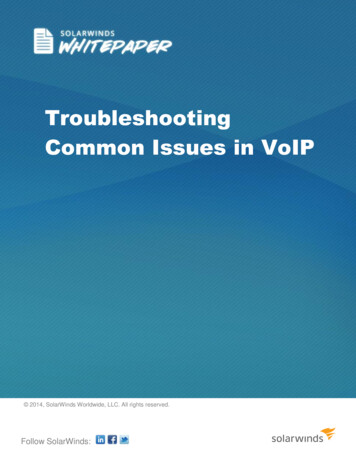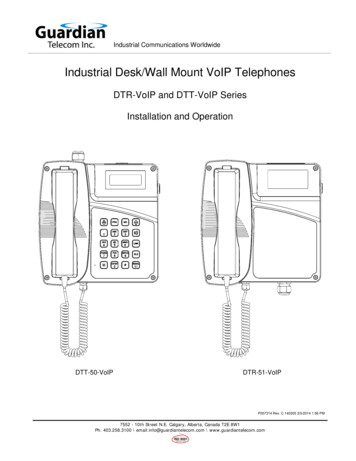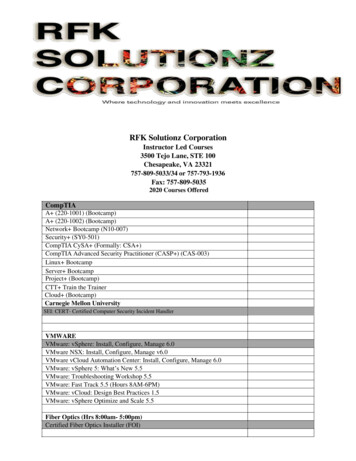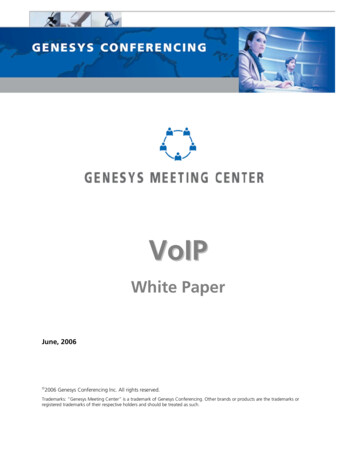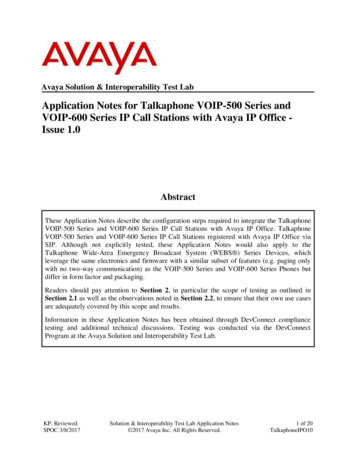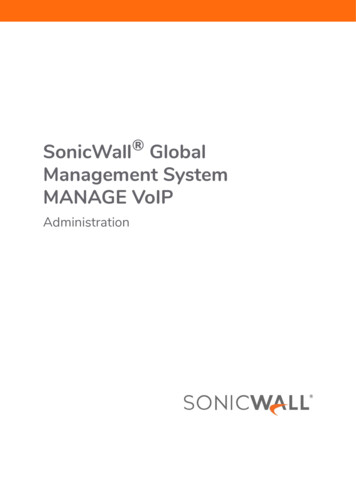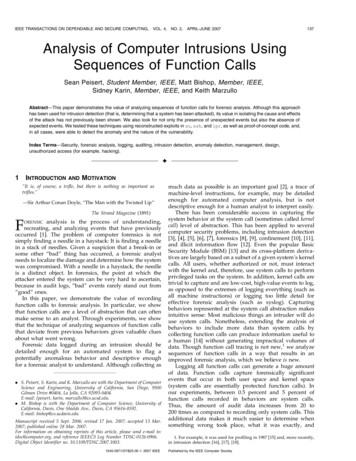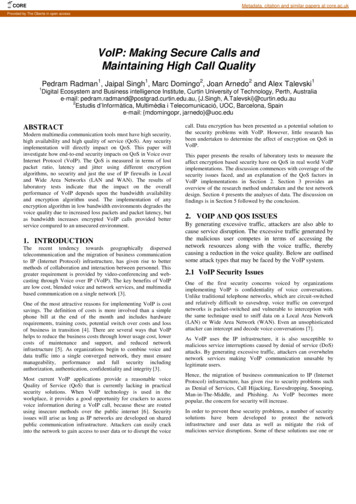
Transcription
COREMetadata, citation and similar papers at core.ac.ukProvided by The Oberta in open accessVoIP: Making Secure Calls andMaintaining High Call Quality1Pedram Radman1, Jaipal Singh1, Marc Domingo2, Joan Arnedo2 and Alex Talevski1Digital Ecosystem and Business intelligence Institute, Curtin University of Technology, Perth, Australiae-mail: pedram.radmand@postgrad.curtin.edu.au, {J.Singh, A.Talevski}@curtin.edu.au2Estudis d’Informàtica, Multimèdia i Telecomunicació, UOC, Barcelona, Spaine-mail: {mdomingopr, jarnedo}@uoc.eduABSTRACTModern multimedia communication tools must have high security,high availability and high quality of service (QoS). Any securityimplementation will directly impact on QoS. This paper willinvestigate how end-to-end security impacts on QoS in Voice overInternet Protocol (VoIP). The QoS is measured in terms of lostpacket ratio, latency and jitter using different encryptionalgorithms, no security and just the use of IP firewalls in Localand Wide Area Networks (LAN and WAN). The results oflaboratory tests indicate that the impact on the overallperformance of VoIP depends upon the bandwidth availabilityand encryption algorithm used. The implementation of anyencryption algorithm in low bandwidth environments degrades thevoice quality due to increased loss packets and packet latency, butas bandwidth increases encrypted VoIP calls provided betterservice compared to an unsecured environment.1. INTRODUCTIONThe recent tendency towards geographically dispersedtelecommunication and the migration of business communicationto IP (Internet Protocol) infrastructure, has given rise to bettermethods of collaboration and interaction between personnel. Thisgreater requirement is provided by video-conferencing and webcasting through Voice over IP (VoIP). The key benefits of VoIPare low cost, blended voice and network services, and multimediabased communication on a single network [3].One of the most attractive reasons for implementing VoIP is costsavings. The definition of costs is more involved than a simplephone bill at the end of the month and includes hardwarerequirements, training costs, potential switch over costs and lossof business in transition [4]. There are several ways that VoIPhelps to reduce the business costs through lower usage cost, lowercosts of maintenance and support, and reduced networkinfrastructure [5]. As organizations begin to combine voice anddata traffic into a single converged network, they must ensuremanageability, performance and full security includingauthorization, authentication, confidentiality and integrity [3].Most current VoIP applications provide a reasonable voiceQuality of Service (QoS) that is currently lacking in practicalsecurity solutions. When VoIP technology is used in theworkplace, it provides a good opportunity for crackers to accessvoice information during a VoIP call, because these are routedusing insecure methods over the public internet [6]. Securityissues will arise as long as IP networks are developed on sharedpublic communication infrastructure. Attackers can easily crackinto the network to gain access to user data or to disrupt the voicecall. Data encryption has been presented as a potential solution tothe security problems with VoIP. However, little research hasbeen undertaken to determine the affect of encryption on QoS inVoIP.This paper presents the results of laboratory tests to measure theaffect encryption based security have on QoS in real world VoIPimplementations. The discussion commences with coverage of thesecurity issues faced, and an explanation of the QoS factors inVoIP implementations in Section 2. Section 3 provides anoverview of the research method undertaken and the test networkdesign. Section 4 presents the analyses of data. The discussion onfindings is in Section 5 followed by the conclusion.2. VOIP AND QOS ISSUESBy generating excessive traffic, attackers are also able tocause service disruption. The excessive traffic generated bythe malicious user competes in terms of accessing thenetwork resources along with the voice traffic, therebycausing a reduction in the voice quality. Below are outlinedsome attack types that may be faced by the VoIP system.2.1 VoIP Security IssuesOne of the first security concerns voiced by organizationsimplementing VoIP is confidentiality of voice conversations.Unlike traditional telephone networks, which are circuit-switchedand relatively difficult to eavesdrop, voice traffic on convergednetworks is packet-switched and vulnerable to interception withthe same technique used to sniff data on a Local Area Network(LAN) or Wide Area Network (WAN). Even an unsophisticatedattacker can intercept and decode voice conversations [7].As VoIP uses the IP infrastructure, it is also susceptible tomalicious service interruptions caused by denial of service (DoS)attacks. By generating excessive traffic, attackers can overwhelmnetwork services making VoIP communication unusable bylegitimate users.Hence, the migration of business communication to IP (InternetProtocol) infrastructure, has given rise to security problems suchas Denial of Services, Call Hijacking, Eavesdropping, Snooping,Man-in-The-Middle, and Phishing. As VoIP becomes morepopular, the concern for security will increase.In order to prevent these security problems, a number of securitysolutions have been developed to protect the networkinfrastructure and user data as well as mitigate the risk ofmalicious service disruptions. Some of these solutions use one or
more techniques such as end device protection using firewalls,and transit communication protection via Virtual Private Network(VPN) and encryption [2].A VPN is a security mechanism that establishes a securityassociation through tunnelling. A VPN can create a secureconnection in Layer 2 and Layer 3 of the Open SystemInterconnection (OSI) communication stack. A layer 2 connectiondoes not need to perform an exclusive privacy protectingtechnique due to its mechanism that provides basic privacy. Incontrast, a layer 3 VPN connection provides high security andprotects user privacy through an IPSec tunnel and Secure SocketLayer (SSL) or Transport Layer Security (TSL), which are morerobust and effective tools for securing communications. The endto-end encryption employed is based on the exchange of a secretkey pair used for data encryption. After this operation, all databetween the two nodes are encrypted [8].Encryption is the process of rendering information unreadable byeveryone except the recipient. Encryption keys work throughencryption algorithms to convert plaintext into ciphertexts(encrypt) and vice versa (decrypt). There are two broad categoriesof encryption keys: asymmetric key, where more than one set ofkeys is utilized, and symmetric key using the same key to encryptand decrypt communication packets. This study only looks atsymmetric encryption algorithms, such as DES, Triple DES (3DES), Blowfish-256, AES-128, AES-256 and RC2 because theseencryption algorithms perform their operations faster thanasymmetrical algorithms. Speed in encryption and decryption isimportant for real-time VoIP communication.Cipher encryption speed can be considered a very important factorwhen assessing an encryption algorithm in terms of strength orweakness. The speed measure includes the amount of time forciphering/deciphering that supports variable parameters such asdata length, which is the length of a plaintext or ciphertext, andkey length [9].Figure 1 shows a comparison of cipher encryption speeds for thechosen encryption algorithms. Another important feature ofencryption algorithms is key size, which contributes directly to thestrength of the encryption, and whether key size affects speed.Table 1 presents a comparison of the selected encryptionalgorithms with regard to key size and speed.2.2 VoIP Quality of Service (QoS)QoS is a major requirement in VoIP implementations. In VoIP,quality means listening and speaking in a clear and continuousvoice, without unwanted noise, long delays, and dropped sound.In order to obtain suitable quality voice conversation andFigure 1: Cipher Encryption Speeds [1].delivering real time data for VoIP over the Internet, the networkneeds to minimize loss and delay of VoIP packets and also reducejitter [10]. Issues such as these must be factored into measuringQoS [2].QoS can be measured in terms of lost packets, latency and jitter(unwanted noise) in a VoIP packet as suggested by Talevski andcolleagues (2008) [4]: Latency or delay is measured by the time taken for voicepackets to travel between two endpoints. It is the time takenfor a VoIP call to get from the speaking person to the listenerat the other end [11]. The latency should be as low aspossible as high latency will disrupt bi-directionalconversations as they speakers will not be in sync with eachother [12]. Lost packets is the failure of one or more packets of datatravelling across the network to reach their destination.Packet loss is one of the important error types in digitalcommunications [13]. In VoIP, loss packets will cause a callto break up, and too much of this will make the conversationuncomprehendable. Jitter is the variation of a periodic signal. In VoIP, jitter is thevariation in time between packets arriving that is usuallycaused by delays inside router queues, due to congestion or achange in network path [14]. No jitter occurs where anetwork has no variation in packet arrival times. High jittermeans the voice quality is inconsistent during a VoIP callsession.There are a number of factors, some controllable and someuncontrollable, that affect voice quality and need to be considered.(a) Bandwidth is the key for voice quality and adequatebandwidth is the most important factor in guaranteeing qualityfor VoIP. This is one of the greatest challenges in networksTable 1: The main features of each encryption algorithm [2].Speed dependson key size?AlgorithmKey size(s) bitsSpeedSecurity / commentsRC240-1024Very fastNoMay be secure for moderatenumbers of encrypted sessions ofmoderate length.Blowfish (BF)128-448FastNoBelieved secure.AES128,192, 256FastYesSecureDES56SlowNoInsecureTriple DES (3DES)112/168Very slowNoModerately secure
today, how to achieve a good voice quality with limited andoften shared bandwidth [15].(b) Codec is a signalling format for sending and receivinginformation when a call is made over the Internet [16]. Acodec with a higher compression ratio and faster algorithmprovides better voice quality and less lost packets and latency.(c) Area network is the arrangement or mapping of the networkelements in the network. Area network is the physical andlogical interconnection between nodes of network elements[17], commonly applied as LANs (Local Area Networks),WANs (Wide Area Networks) and MANs (Metropolitan AreaNetworks).2.3 Impact of Security on QoSThe implementation of security protocols in VoIP applicationswould require additional resources, which will impact on thequality of the voice call. QoS protocols try to meet the imposedrequirements using different features such as packet classification,queuing mechanisms, header compression, and congestionavoidance strategies. Unfortunately, such features cannot be usedto advantage in combination with security protocols as they utilizefields in the IP header. Therefore, when security protocols areimplemented, the possible choices of QoS protocols are limited[18].Previous works have only measured the impact of encryptionalgorithms on VoIP applications in three different bands in WANs[19]. In this paper, the impact of encryption algorithm in terms oflost packet ratio, latency and jitter on both LAN and WAN withdifferent bandwidths are examined. The best encryption algorithmthat provides acceptable security along with acceptable quality ofservices, has been nominated and discussed.3. RESEARCH METHODOLOGYThe research method applied for this research is a laboratoryexperiment. It entails the gathering of data from experiments andthe analysis of that data to build findings that answer the researchquestion and are meaningful in the context of the research.Encryption Algorithm and Bandwidth are the independentvariables. These characteristics have been chosen from previousliterature on QoS in VoIP. The dependent variables are Latency,Jitter and Lost packets. These variables define the quality of aVoIP call. In the context of this research “Unacceptablebandwidths” is defined as that which cannot provide an averagelatency of less than 0.050ms seconds as well as that bandwidth,which generates more than 20% lost packet ratios."Asignificantly detrimental impact on QoS" is defined as any impact,which reduces QoS to the point where VoIP communication isunacceptably poor.3.1 VoIP Network DesignTwo network areas have been configured in the test networkrepresenting a LAN and WAN. The LAN was represented by twocomputers connected via a cross cable and the WAN wasrepresented by connecting two groups of computers via two Cisco2500 routers as the base platform. The two routers were connectedvia a serial link enabling them to ping each other. By alsoconfiguring the Ethernet interfaces of the routers to establish aconnection from the attached computer from a LAN to eachrouter, the two computers from two different area networks wereable to communicate with each other (see Figure 2). Theconfiguration of the test network is as follow: 100 Mbps bandwidth for the LAN. Three different bandwidths of 19k, 38k and 64k for theWAN.For measurement of impact of implementation of encryptionalgorithms to VoIP, different scenarios were conducted in the testnetwork at different bandwidth speeds. This design usedNetmeeting as the Conferencing software, Wireshark as the packetsniffer, OpenVPN as the VPN software, which enables us toimplement different encryption algorithms and Windowsoperating system from Microsoft along with its Firewall feature.Netmeeting was used as the VoIP client as it allows for peer-topeer communication and it allows the use of different encryptionalgorithms through a VPN client.Each packet carrying voice data travelling between the sender andreceiver was captured using Wireshark. The Wireshark output wasthen converted to XML.For calculating these three factors such as lost packet ratio,latency and jitter, the XML file was exported to an Excel file.These factors are calculated through two tags such as data andtimestamp. In fact, data helps to find the lost packet ratio andtimestamp was used for calculating latency and jitter.Three scenarios were conducted in the test network to measure theimpact of the different encryption algorithms on VoIP:(a) No Security: Running Netmeeting, Wireshark and disablingWindows Firewall on both PC. No encryption algorithm was usedfor the VoIP calls.(b) Firewall Only: Running Netmeeting, Wireshark andenabling Windows Firewall on both PC. No encryption algorithmwas used for the VoIP call.(c) With Windows Firewall and different encryptionalgorithms: Running Netmeeting, Wireshark, enabling WindowsFirewall and OpenVPN with different encryption algorithms forVoIP calls between the sender and receiver.The measurement of the dependent variables - latency, jitter andlost packet - in the test network was used to assess the impact ofdifferent area networks and bandwidths on QoS using the abovethree scenarios. As this research was conducted in an isolatedlaboratory, it was not necessary to measure the dependent variableregularly many times. Once the experiment recorded consistentaverage latency time, jitter and lost packet for each scenario, theresults were reliable throughout the experiments.
LAN 1LAN 2Figure 2: The WAN Test Network Designalgorithms and scenarios does not largely impact on QoS in termsof degree of latency.4. DATA ANALYSISFive different encryption algorithms were implemented with threedifferent bandwidth speeds in the laboratory to measure the degreeof latency, jitter and lost packet ratio by different encryptionalgorithms.The lab experiment results in a low bandwidth situation, wherethe bandwidth is 19kbps, show that implementation of encryptionalgorithms causes a high degree of latency of around 0.50ms andthat the lost packet ratio jumps to around 50%. However,implementing No Security has slightly less jitter thanimplementing encryption algorithms. As such a low bandwidthmakes it difficult to implement sufficient quality in VoIP calls, theresults of 19kbps bandwidth speed is not presented it this section.4.1 LatencyFigure 3 shows the degree of latency for three different bandwidthusing different security encryption algorithms, “Firewall” and “NoSecurity”.As it can be seen from Figure 3, the degree of latency is improvedby increasing bandwidth.As the diagram shows, implementing the BF and AES encryptionalgorithms in the 38kbps bandwidth generate a great deal oflatency, which is about 0.040ms. In contrast, other encryptionThe diagram also indicates that in 64kbps, the degree of latencywould not be influenced by implementing the security schemas.This figure reveals that implementing a 3DES encryptionalgorithm is the worst encryption in terms of high latency, whichis around 0.016ms and is the greatest degree of latency incomparison with other encryption algorithms in 64k bandwidth,while AES encryption has the least degree of latency.In addition, the degree of latency for a LAN is shown in100Mbps. It indicates that implementation of security schemassuch as encryption algorithms and firewall does not negativelyaffect the degree of latency.Overall, the degree of latency is not influenced by implementingencryption algorithms and firewall where the bandwidth isincreased from 38Kbps to 64Kbps or 100Mbps,4.2 JitterFigure 4 shows the degree of jitter ratios. It reveals that the degreeof jitter is improved by increasing bandwidth except in scenario ofFirewall Only security implementation. This means, the degree ofjitter is raised by changing the bandwidth from 38kbps to 64kbps.However, in a LAN (100Mbps) the amount of jitter is dropped toFigure 3: Degree of Latency
almost 0ms.As can be observed from the figure, implementing RC2encryption algorithm decreased the degree of jitter dramatically,while the degree of jitter is higher when no encryption algorithmis used.of lost packet. 3DES implementations only have 4% loss packets,lower than all other scenarios.In 64kbps, 3DES encryption algorithm along with Firewall Onlyscenario has the highest loss packet ratio, which is around 4%.AES-128 and RC2 encryption algorithms only generate less thanFigure 4: Degree of JitterIn a WAN, the degree of jitter is reduced drastically for DES, AESand RC2 encryption algorithms when the bandwidth increases to64kbps, whereas the jitter is high for VoIP communicationwithout any encryption algorithms and activating WindowsFirewall only. In a firewall only scenario, the degree of jitterincreases to 0.032ms when the WAN bandwidth increases, whichis the greatest degree of jitter among all scenarios. In a LAN withhigh bandwidth (100Mbps), the degree of jitter is decreased toalmost 0ms for 3DES, No Security and Firewall Onlyimplementations.4.3 Lost PacketsFigure 5 shows the degree of lost packets and bandwidth has avery important role in measurement of lost packet ratios.As can be seen, implementing the BF and AES encryptionalgorithms in the 38kbps bandwidth WAN generate a great deal oflost packet ratio, which is more than 10%. However,implementing 3DES encryption algorithm decreased the number1% lost packet which is negligible in VoIP communication.In a LAN with 100Mbps, the increased bandwidth should haveimproved QoS. However, implementation of RC2 algorithmgenerates more lost packets in comparison with other scenarios inthis bandwidth. The RC2 implementation generates more lostpackets in a LAN than in 64kbps WAN and even more thanimplementing AES and BF encryption algorithm in 64kbps WAN.5. DISCUSSIONInformation security is a trade-off between ease of use andconvenience and restriction for protection from misuse. Similarlysecurity in VoIP can be defined as the process of achieving abalance between secure communications and high qualitycommunications.The results indicate that bandwidth speed has a very importantrole in selecting an encryption algorithm. The figures in section 4illustrate the effects of implementing the chosen encryptionalgorithms on voice quality in VoIP in an effort to establish whichFigure 5: Lost Packet Ratio
encryption algorithm is most effective in different bandwidths anddifferent networks (LAN and WAN). Table 2 summarizes theresults showing desired factors of security, speed, latency, jitterand lost packets for the selected encryption algorithms, rating theeffectiveness of each in ascending order (1 low and 6 high).The log files from the laboratory experiments demonstrate that theinitial application of the AES encryption algorithm results in ahigh ratio of lost packets which reduces the quality of voice, butimproves as the procedure continues. For example, implementingAES encryption algorithms in 38k bandwidth (WAN), which is anacceptable and minimum bandwidth for implementing encryptionalgorithms in this research, generates significant lost packets at thebeginning of the connection. However, it should be mentionedthat the encryption standard of the United States National Instituteof Standards and Technology (NIST), and the United Statesgovernment reportedly approves AES encryption algorithm forTable 2: The encryption algorithm 6RC2RC2BFencrypting top-secret documents (NIST 2008). This algorithmaffects the quality of voice more than the BF encryptionalgorithm. As a result, if a completely secure communication isdesirable, the implementation of AES encryption algorithms isessential because the impact of AES on quality of voice isacceptable.Findings from this research indicate that DES and 3DES shouldbe rejected because DES encryption is not secure and 3DES onlyprovides Moderate Security while being very slow in terms ofspeed of encrypting and decrypting. However, these twoencryption algorithms have slightly less impact on voice qualitythan AES.Results in laboratory shows that by increasing bandwidth, a greatdeal of lost packet ratio is dramatically decreased and byremoving encryption algorithms and the firewall the lost packetratio is improved. According to the log files, there are a greatnumbers of Not Found packets at the beginning of connection,which implemented by AES encryption algorithms, whether 128or 256 key lengths. It means, the reason that increases lost packetratios in these two encryption algorithms, is the establishingconnection at the beginning.Encryption affects voice traffic in two ways. It increases packetsize because of the headers added to the original IP packet forconfidentiality and the new IP header added for the tunnel. Thesecond is the time required to encrypt the payload and headers andconstruct the new header. There are undoubtedly many otherfactors that affect QoS and these have not been included in thisresearch.6. CONCLUSIONThis research examined the impacts of implementing a number ofencryption algorithms on the quality of service in VoIP with theaffects being measured in terms of latency, jitters and lost packets.Bandwidth limitation is one of the major issues in the VoIPnetwork, so different area networks, bandwidths and encryptionalgorithms have been investigated in this research. The resultsshow that the three factors of QoS - latency, jitter and lost packets- are all improved through increased bandwidth.However experiments in the laboratory demonstrated that byimplementing encryption algorithms the amount of jitter isdecreased, but significantly raises the degree of latency and lostpackets that sometimes depend on the bandwidth speeds, leadingto VoIP becoming unusable. Employing encryption algorithms ina VoIP environment completely depends on required applicationsand a single answer is not forthcoming and much depends uponthe desired factor rated most important.In the search for the encryption algorithm providing an acceptablelevel of security and in addition to the best quality of voice thefollowing recommendations are offered.The RC2 encryption algorithm is recommended as the mostsuitable encryption algorithm, when users are seeking featuressuch as speed, least latency and jitter. The RC2, unlike DES,algorithm is very fast and provides the least latency and jitter aswell as an acceptable level of lost packets. It means if speed isdesired then the RC2 is the most effective. However, thisencryption algorithm provides only moderate security, but isrecommended in some environments where speed and voicequality have priority over security. It is concluded form the resultsthat DES is the most ineffective encryption algorithm in terms ofsecurity and speed among those which have been examined in thispaper.In addition, this paper indicated that the BF and AES encryptionalgorithms present the best security among those examined in thisresearch. Therefore, in a situation where security is the mostimportant objective, then AES-256 is the most effective and DESthe most ineffective. Where latency or jitter is the most important,then RC2 is superior and BF is the most inferior.Also, this research demonstrated that BF is the most effectivealgorithm for minimizing lost packets ratios in contrast to AES128 which rates the lowest for this factor. Furthermore, it shouldbe mentioned that the BF encryption algorithm provides anacceptable level of security, which is Believed Secure, as well asless impact on voice quality than the AES encryption algorithm.Both encryption algorithms are recommended in some situationswhere security is desirable, such as financial and armyapplications. However, the AES encryption algorithm providesbetter security than BF, but AES has a greater impact on QoS inVoIP applications than BF.Further research is needed to identify factors that may affect voicequality, such as congestion, routing protocol, different codec and
type of network determine the effects these have upon the QoS inVoIP. This will be presented in future work.[16]7. ml, [Accessed: 1 May 2009].Z. A. Barnes, "Is implementation of voice over internetprotocol (voip) more economical for businesses withlarge call centers," Bowie State University 2005.E. T. Aire, B. T. Maharaj, and L. P. Linde,"Implementation considerations in a sip based securevoice over IP network," in Proc of the 7th AFRICONConference in Africa (AFRICON), Botswana, 2004, pp.167-172.Cisco Systems, "Cisco IP communications solutions," /netsol/ns165/c643/cdccont 090, [Accessed: 23 October2008].A. Rouse, "Voice over IP revolutionizing the waybusinesses communicate," in The Communicator. vol. tepapers/voip.pdf, 2004.A. Talevski, E. Chang, and T. Dillon, "Secure andmobile voip," in Proc. of the International Conferenceon Convergence Information Technology, Korea, 2007,pp. 2108-2113.P. Thermos and A. Takanen, Securing voip networks:Threats, vulnerabilities, and countermeasures. Boston,USA: Pearson Education, Inc., 2008.R. Weaver, "Vpn implementations," in Guide tonetwork defense and countermeasures, 2nd ed USA:Thomson Course Technology, 2007, pp. yptix.com/files/speed-paper.pdf,[Accessed: 4 May 2009].Cisco Systems, "Understanding delay in packet voicenetworks," in Document Id: 5125, Available delaydetails.pdf, [Accessed: 23 October 2008].N. Sulaiman, R. Carrasco, and G. Chester, "Impact ofsecurity on voice quality in 3g networks," in Proc. of the3rd IEEE Conference on Industrial Electronics andApplications (ICIEA), Singapore, 2008, pp. 1583-1587.A. P. Markopoulou, F. A. Tobagi, and M. J. Karam,"Assessing the quality of voice communications overinternet backbones," IEEE/ACM Transactions onNetworking, Vol. 11, No. 5, 2003, pp. 747-760.M. Minasi, "Locking up the ports: Windows firewall,"in Mastering windows server 2003, upgrade edition forsp1 and r2 Indianapolis, USA: Sybex, 2006.M. Manousos, S. Apostolacos, I. Grammatikakis, D.Mexis, D. Kagklis, and E. Sykas, "Voice qualitymonitoring and control for VoIP," IEEE InternetComputing, Vol. 9, No. 4, 2005, pp. 35- 42.S. Na and S. Yoo, "Allowable propagation delay forvoip calls of acceptable quality," in Proc. of the 1stInternational Workshop (AISA), Seoul, Korea, 2002, pp.47-55.[17][18][19]Ciso Systems, "Understanding codecs: Complexity,hardware support, mos, and negotiation," iestech note09186a00800b6710.shtml, [Accessed: 4 May2009].S. Tanenbaum, Computer networks, 4th ed. New Jersey,USA: Pearson Education, 2003.R. Barbieri, D. Bruschi, and E. Rosti, "Voice over ipsec:Analysis and solutions," in Proc. of the 18th AnnualComputer Security Applications Conference, San Diego,USA, 2002, pp. 261- 270.P. Radmand and A. Talevski, "Impact of encryption onQoS in VoIP," in Proc of 2nd IEEE InternationalConference on Information Privacy, Security, Risk andTrust (PASSAT), USA, 2010, p. (accepted forpublication).
2.2 VoIP Quality of Service (QoS) QoS is a major requirement in VoIP implementations. In VoIP, quality means listening and speaking in a clear and continuous voice, without unwanted noise, long delays, and dropped sound. In order to obtain suitable quality voice conversation and delivering real time data for VoIP over the Internet, the network .
